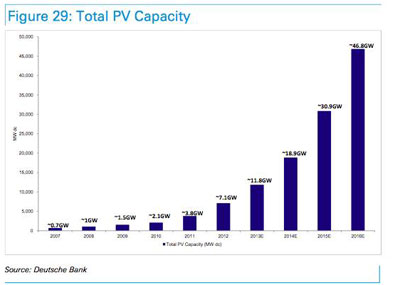We end the year with fantastic news for US solar.
2014 will be the best year yet, with another 7.4 GW of solar PV added – a 42% jump from 2013, another very strong year.
That brings the US total close to 20 GW and it’s expected to double again in the next two years! For the first time, each major segment – utility, commercial and residential – installed more than a gigawatt (GW) of solar PV, says GTM Research and the Solar Energy Industries Association.
This year, the US solar industry crossed the threshold – providing 1% of US electricity. If it reaches 50 GW by the end of 2016, as Deutsche Bank projects, it will be supplying 2%.

"Every three minutes, the US solar industry flips the switch on another completed solar project," says Rhone Resch, CEO of Solar Energy Industry Association (SEIA). Across the US, there are 600,000 individual solar installations – on rooftops, parking lots, landfills, deserts and fields – supplying enough solar for 4 million homes.
In the third quarter, 1.35 GW of solar PV was installed – up 41% over Q3 2013 – with 825 MW of utility-scale projects coming online and over 300 MW of residential solar PV, half of which didn’t have state incentives. 175,000 people are employed by the industry, according to SEIA and GTM Research.
What’s behind the astronomical growth?
The sharp drop in solar prices – down 53% since 2010 – and cheaper financing costs. Even if federal tax credits change, Deutsche Bank expects financing costs to fall from 7-9% now to around 5.4% next year, helping new financing models like Yieldcos, solar loans, asset backed securities and retail bond offerings.
If Congress renews the Investment Tax Credit (ITC), Deutsche Bank expects solar to reach grid parity in 47 states by 2016 – up from 10 now – setting the scene for much bigger increases, says Vishal Shah, a solar analyst there.
Even if the ITC is allowed to expire, it’s not crucial anymore, says the Bank, because of falling prices and ease of financing.
The one thing that could derail these projections are moves by utilities and groups like ALEC to shunt, if not eliminate growth, says Shah.
But even if they manage to cut growth to only 22% a year – half what we saw this year – solar would still reach 10% of US electricity over the next decade or so, accounting for half the emissions cuts required under EPA’s power plant regulations.
Besides Renewable Portfolio Standards, core policies are:
- Investment Tax Credit (ITC): At the end of 2016, the federal ITC – the bedrock incentive for the US solar market – drops from 30% to 10% for commercial projects and to zero for directly owned residential projects. Financing is already more difficult for utility-scale projects with long lead times.
- Net metering and utility rate structures. Utilities across the country are pushing for fixed charges for solar owners and net metering is under attack in the states, although this year there haven’t been significant rollbacks.
- Impact of greenhouse gas regulations. States will be developing plans for how to meet EPA’s power plant emission caps, presenting new opportunities for solar.
Find out how your state ranks on solar:
